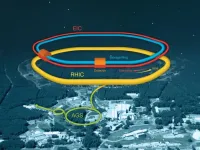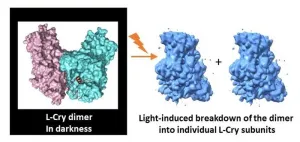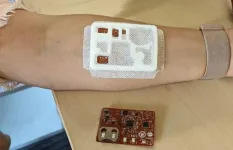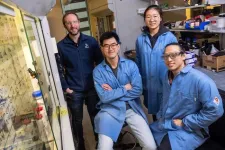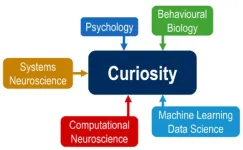(Press-News.org) ST. LOUIS, MO, November 13, 2023 — An international research team led by James Umen, PhD, member, Donald Danforth Plant Science Center has made an unexpected discovery of a biased counting mechanism used by the single-celled green alga Chlamydomonas to control cell division. Chlamydomonas cells can grow very large and then divide multiple times in succession. The team found that the number of divisions a mother cell undertakes to restore its daughters to the correct starting size deviates from the mathematical optimum that was assumed to dictate this process. Instead, mother cells almost never divided just one time—they either didn’t divide at all or divided two or more times. This unexpected bias against a single division has important implications for understanding the evolution of multicellular life and provides a new avenue for engineering algal cells for improved yields of biofuel and high value products. The article describing these findings titled, "A Cell-Based Model for Size Control in the Multiple Fission Alga Chlamydomonas reinhardtii," was published on November 9, 2023, in the journal Current Biology.
Chlamydomonas cells, like those of many other algae and single-celled protists, can grow very large before they divide. This atypical growth and division pattern lets them make optimal use of light and nutrients, but also creates a problem in size control: Under some conditions cells will just barely double their size before it is time to divide and only need to divide once; but under favorable conditions the same cell might grow more than ten times its starting size and would need to divide multiple times in succession to produce daughters of the correct size. This size variability presents a conundrum which was solved by the evolution of a mechanism in Chlamydomonas that enables cells to assess their size and count out the correct number of cell divisions. “It was always assumed that the division pattern was dictated by a simple relationship between mother cell size and number of divisions, and models that assume this simple relationship can accurately predict the behaviors of entire cell populations,” said Umen. “But by looking at division behaviors of thousands of individual cells of varying sizes we found an unanticipated dearth of cells dividing just once.” Instead, cells that should have divided once opted to not divide at all, and most cells only became able to divide when they had more than doubled in size.
Faced with this unexpected result, team members Abhyudai Singh, PhD, professor, University of Delaware and César Augusto Vargas-García, PhD, analytics team leader, AGROSAVIA -Corporación colombiana de investigación agropecuaria, Bogotá, Colombia, used mathematical modeling to come up with a more accurate predictive model for the behavior of the cells, while the research team at Danforth Center, spearheaded by Dianyi Liu, PhD, postdoctoral associate, dug deeper to understand the genetic mechanisms that produced the observed counting bias. The team discovered that a well-known, but still poorly-understood genetic mechanism for controlling cell division found in algae, plants and humans—called the retinoblastoma tumor suppressor pathway—plays a critical role in preventing just one division.
“While we are just at the start of understanding how the retinoblastoma pathway works in algae, the discovery of a mechanism for introducing bias in cell division behavior immediately suggests a way that cells modified their division behavior as an important step in the evolution of multicellular life,” according to Liu.
Multicellular relatives of Chlamydomonas not only skip the option to undergo one division but can prevent division until they have grown many times in size. This enables a single cell to rapidly produce a whole new multicellular individual with hundreds or even thousands of cells, an ability that is critical for fitness and survival. “The bias against one division we observed in Chlamydomonas was very likely present in direct ancestors of its multicellular relatives and was further amplified as they evolved greater size and complexity,” speculates Umen. While it remains unclear why the cells evolved a bias against dividing just once, the knowledge of this mechanism and its genetic control has practical implications in algal biotechnology where cell size can impact yields of high value products and even susceptibility to predation of algae by filter feeders in open pond cultures.
Looking forward, the team is now focused on understanding and modeling the specific mechanisms used by the retinoblastoma pathway to alter cell division behavior in algae, work that may lead to advances in algal biotechnology and even shed light on how the retinoblastoma pathway keeps human cells from developing cancer and prevents plant cells from dividing at the wrong time and place.
The team's research success was supported by National Institutes of Health grants R01GM126557 and R35GM148351.
About the Donald Danforth Plant Science Center
Founded in 1998, the Donald Danforth Plant Science Center is a not-for-profit research institute with a mission to improve the human condition through plant science. Research, education, and outreach aim to have impact at the nexus of food security and the environment and position the St. Louis region as a world center for plant science. The Center’s work is funded through competitive grants from many sources, including the National Science Foundation, National Institutes of Health, U.S. Department of Energy, U.S. Agency for International Development, the Bill & Melinda Gates Foundation and through the generosity of individual, corporate and foundation donors. Follow us at @DanforthCenter.
About The Enterprise Rent-A-Car Institute for Renewable Fuels
The Enterprise Institute at the Danforth Center leverages bioenergy crops to create green solutions for global challenges. Danforth Center scientists are working to develop plant-based materials, or feedstocks, for bioenergy that are more environmentally sustainable and higher in energy content.
For more information contact:
Karla Roeber, Vice President, Public and Government Affairs, kroeber@danforthcenter.org
END
New discovery on how green algae count cell divisions illuminates key step needed for the evolution of multicellular life
2023-11-13
ELSE PRESS RELEASES FROM THIS DATE:
French and U.S. science agencies take first step to collaborate on electron-ion collider (EIC)
2023-11-13
PARIS, NOV. 13—Representatives from the U.S. Department of Energy’s (DOE) Office of Science and the French Alternative Energies and Atomic Energy Commission (CEA) have signed a “Statement of Interest” to launch what both agencies hope will be a significant collaboration on the Electron-Ion Collider (EIC). The EIC, being built in the U.S. at DOE’s Brookhaven National Laboratory in partnership with DOE’s Thomas Jefferson National Accelerator Facility (Jefferson Lab), will be a unique facility for exploring the building blocks of matter and the strongest force in nature. The agreement continues a long history of cooperation in scientific ...
Study finds people with inflammatory arthritis face significant psychological challenges in maintaining employment
2023-11-13
SAN DIEGO, CA, NOVEMBER 13, 2023 — Research from Hospital for Special Surgery (HSS) reveals a significant psychological impact related to inflammatory arthritis patients’ efforts to maintain employment while coping with the challenges of their illness. The study, titled “The Psychological Experience of Work for People with Inflammatory Arthritis (IA),” was presented at the American College of Rheumatology (ACR) Convergence 2023 on November 13 in San Diego.
“A large body of research indicates that people with inflammatory arthritis are at increased risk for work disability, which can profoundly affect their lives. ...
How marine bristle worms use a special protein to distinguish between sunlight and moonlight
2023-11-13
In a recent publication in Nature Communications, a joint research team of Johannes Gutenberg University Mainz (JGU), the University of Cologne, and the University of Oldenburg has presented their findings on the functioning of an atypical cryptochrome protein (Cry). These proteins are found in a variety of organisms, and they are often involved in light-controlled biological processes. The marine bristle worm Platynereis dumerilii, for example, employs a special Cry protein designated L-Cry to distinguish between sunlight and moonlight as well as between different moon phases. This is essential for the worms ...
Artificial intelligence: Unexpected results
2023-11-13
Artificial intelligence (AI) is on the rise. Until now, AI applications generally have “black box” character: How AI arrives at its results remains hidden. Prof. Dr. Jürgen Bajorath, a cheminformatics scientist at the University of Bonn, and his team have developed a method that reveals how certain AI applications work in pharmaceutical research. The results are unexpected: the AI programs largely remembered known data and hardly learned specific chemical interactions when predicting drug potency. The results have now been published in Nature Machine Intelligence.
Which drug molecule is most effective? Researchers are feverishly ...
Migrant couples have better relationships when they can balance old and new cultures
2023-11-13
BINGHAMTON, N.Y. -- Migrant couples who can effectively balance the culture of their homeland while adapting to the dominant culture of their new home are more likely to have a better relationship, according to newly published research from psychologists at Binghamton University, State University of New York.
“When immigrants venture into a new country, they embark on a journey of blending cultures while keeping their roots alive,“ said Binghamton University PhD candidate Quinn Hendershot. “There has been limited research on how their ability to adjust to a new culture while embracing the cultures of their homeland can affect the relationship.”
Hendershot ...
Worcester Polytechnic Institute researcher leads project to develop oxygen sensor for premature infants of color
2023-11-13
– The National Institutes of Health (NIH) has awarded $1.1 million to a team led by Worcester Polytechnic Institute (WPI) researcher Ulkuhan Guler to develop a first-of-its-kind wearable sensor for premature infants that will address racial bias in healthcare by monitoring oxygen levels two different ways and correcting the measurements to account for variations in skin color.
The four-year project will create a convenient, affordable, noninvasive sensor about the size of a bandage that will enable infants at risk of lung disease to leave hospitals sooner and be accurately monitored at home, said Guler, an associate professor in the Department ...
Fluorine catch-and-attach process could boost drug efficiency
2023-11-13
HOUSTON – (Nov.13, 2023) – When it comes to chemical reactions, fluorine has a reputation as a ‘magic bullet atom’ for its ability to increase a drug’s absorption and prolong its lifetime. However, traditional methods of adding it to compounds entail expensive materials and can be difficult to pull off.
Rice University scientists developed a reliable and cost-effective process of adding fluorine to molecules for increased pharmaceutical drug efficiency using an iron and ...
New assay could revolutionize detection and treatment of acute myeloid leukemia
2023-11-13
Philadelphia, November 13, 2023 – A novel assay that detects a unique molecular marker in patients with acute myeloid leukemia (AML) may revolutionize the way this disease is detected and treated according to a new report in The Journal of Molecular Diagnostics published by Elsevier. This assay may improve detection of AML driven by KMT2A gene fusions and may affect treatment decision-making, assessing response to therapy, and long-term surveillance.
AML is a rare, aggressive blood cancer diagnosed in around 120,000 individuals worldwide each year. Detecting residual disease during treatment is essential for determining prognosis and ...
Curiosity and pure maths
2023-11-13
The German Research Foundation (DFG) will be funding a new Research Training Group (RTG) at the University of Göttingen from next year. The RTG "Curiosity" is based at the Faculty of Biology and Psychology. Funding is expected to total around 7.8 million euros over the following five years. In addition, the DFG has extended the funding for the RTG "Fourier Analysis and Spectral Theory" at the Faculty of Mathematics and Computer Science by five years. The award for this RTG totals around 4.5 million euros over the extended funding period.
Curiosity is broadly defined ...
Limited positive childhood experiences linked to higher binge-eating risk in college
2023-11-13
New findings from the University of Houston Department of Health and Human Performance reveal a significant association between a lower number of positive childhood experiences and a higher prevalence of binge-eating disorder characteristics, as well as lower scores for intuitive eating.
Binge eating, which includes consuming a substantial amount of food within a brief timeframe and experiencing a loss of control, is linked to adverse weight-related health effects and challenges in mental well-being. Intuitive eating, ...
